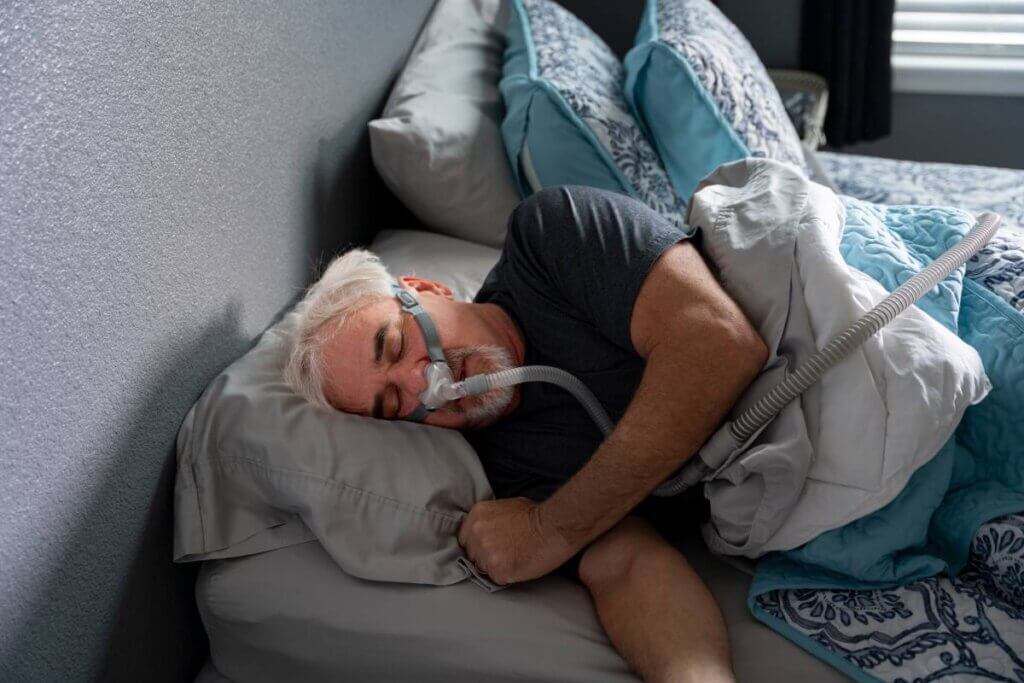
Glucagon-like-peptide-1 (GLP-1) drugs are a class of medications initially developed to treat type 2 diabetes. These drugs, also known as GLP-1 receptor agonists, stimulate the body to produce more insulin and lower blood glucose levels.1 Recently, GLP-1 drugs have exploded in popularity as an obesity treatment, as they lower the rate of gastric emptying, which leads to an increased feeling of satiety. Major GLP-1 drugs include semaglutide (sold under brand names Ozempic and Wegovy) and tirzepatide (brand names Mounjaro and Zepbound). As researchers continue to explore other effects of GLP-1 drugs, their potential impact on sleep apnea has garnered interest.
In the latest sign that GLP-1 agonists are an extremely versatile drug class, recent data suggests that they are effective in treating a common sleeping disorder known as obstructive sleep apnea (OSA). OSA occurs when breathing is momentarily interrupted during sleep due to the obstruction of the airway by relaxed throat muscles. Symptoms of OSA include arousal from sleep, loud snoring, and daytime fatigue, and it is implicated in mental illness and cardiovascular health.2 Sleep apnea also requires careful airway management during anesthesia and surgery.
A June 2024 research paper published in The New England Journal of Medicine described how the GLP-1 agonist tirzepatide lowered the incidence of OSA and improved sleep-related outcomes, in addition to reducing body weight, hypoxic burden (which measures the severity of sleep apnea), and systolic blood pressure.3 The research was part of the SURMOUNT-OSA trial, which sought to compare the efficacy and safety of tirzepatide compared to placebo in adults with moderate-to-severe OSA.4 There were separate trials for those who were unable or unwilling to use positive airway pressure (PAP) therapy (Trial 1) and those who remained on PAP therapy throughout the trial (Trial 2).
During the trial, which was supported by tirzepatide manufacturer Eli Lilly, participants administered tirzepatide experienced a significant decrease in number of apnea and hypopnea (abnormally slow breathing) events per hour during sleep. Specifically, individuals in Trial 1 who received tirzepatide experienced on average 25 fewer apnea events per hour, compared to 5 fewer apnea events per hour in the placebo group. Similarly, in Trial 2, individuals administered tirzepatide experienced an average reduction of 29 apnea events per hour, compared to a reduction of 5 in the placebo. 70% and 86% of individuals in the tirzepatide groups of Trials 1 and 2, respectively, experienced a reduction of at least 50% in the number of pre-trial apnea events by the end of the trial.
Though the SURMOUNT-OSA trial may have been the first to rigorously make the case for using GLP-1 agonists to treat sleep apnea, other researchers had previously hypothesized that the drugs could prove useful for this condition. A 2022 review article argued that GLP-1 agonists should be prescribed as a “one-stop-shop” for patients with OSA and its comorbidities, including obesity, hypertension, diabetes, and atherosclerotic cardiovascular disease.5 Though the mechanism(s) by which GLP-1 agonists reduce the effects of OSA has yet to be determined — and GLP-1 has been found to reduce apnea events independent of weight loss 6 — OSA and the other health conditions that commonly occur alongside it are all responsive to GLP-1 drugs. If future studies and trials reinforce the findings of the SURMOUNT trial, patients with sleep apnea, in addition to those with diabetes and obesity, may soon turn to GLP-1 drugs.
References
- Collins, L. & Costello, R. A. Glucagon-Like Peptide-1 Receptor Agonists. in StatPearls (StatPearls Publishing, Treasure Island (FL), 2024).
- Slowik, J. M., Sankari, A. & Collen, J. F. Obstructive Sleep Apnea. in StatPearls (StatPearls Publishing, Treasure Island (FL), 2024).
- Malhotra, A. et al. Tirzepatide for the Treatment of Obstructive Sleep Apnea and Obesity. N. Engl. J. Med. 2024, DOI: 10.1056/NEJMoa2404881
- Tirzepatide for the treatment of obstructive sleep apnea: Rationale, design, and sample baseline characteristics of the SURMOUNT -OSA phase 3 trial – PubMed. https://pubmed.ncbi.nlm.nih.gov/38547961/, DOI: 10.1016/j.cct.2024.107516
- Sultana, R., Sissoho, F., Kaushik, V. P. & Raji, M. A. The Case for Early Use of Glucagon-like Peptide-1 Receptor Agonists in Obstructive Sleep Apnea Patients with Comorbid Diabetes and Metabolic Syndrome. Life 12, 1222 (2022), DOI: 10.3390/life12081222
- Blackman, A. et al. Effect of liraglutide 3.0 mg in individuals with obesity and moderate or severe obstructive sleep apnea: the SCALE Sleep Apnea randomized clinical trial. Int. J. Obes. 2005 40, 1310–1319 (2016), DOI: 10.1038/ijo.2016.52



